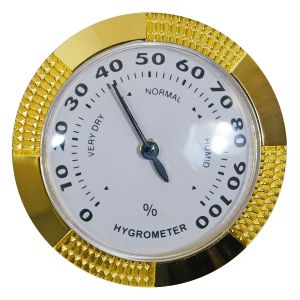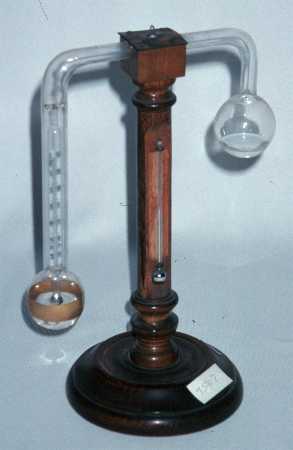Hygrometers
Hygrometer is an instrument used for measuring the moisture content in the environment. Humidity measurement instruments usually rely on measurements of some other quantity such as temperature, pressure, mass or a mechanical or electrical change in a substance as moisture is absorbed. By calibration and calculation, these measured quantities can lead to a measurement of humidity. Modern electronic devices use temperature of condensation, or changes in electrical capacitance or resistance to measure humidity changes.
Types
Metal-paper coil type
The metal-paper coil hygrometer is useful for giving a dial indication of humidity changes. It appears most often in very inexpensive devices, and its accuracy is limited, with variations of 10% or more. In these devices, humidity is absorbed by a salt-impregnated paper strip attached to a metal coil, causing the coil to change shape. These changes cause an indication on a dial.
Hair tension hygrometers
These devices use a human or animal hair under tension. The length of the hair changes with humidity and the length change may be magnified by a mechanism and/or indicated on a dial or scale. The traditional folk art device known as a weather house works on this principle.
Electronic hygrometers
Chilled mirror dew point hygrometers
Dew point is the temperature at which a sample of moist air at constant pressure reaches water vapor saturation. At this saturation temperature, further cooling results in condensation of water. Chilled mirror dew point hygrometers are some of the most precise instruments commonly available. These use a chilled mirror and optoelectronic mechanism to detect condensation on the mirror surface. The temperature of the mirror is controlled by electronic feedback to maintain a dynamic equilibrium between evaporation and condensation on the mirror, thus closely measuring the dew point temperature. An accuracy of 0.2 °C is attainable with these devices, which correlates at typical office environments to a relative humidity accuracy of about ±0.5%. These devices need frequent cleaning, a skilled operator and periodic calibration to attain these levels of accuracy.
Capacitive humidity sensors
For applications where cost, space, or fragility are relevant, other types of electronic Sensors are used, at the price of a lower accuracy. In capacitive humidity sensors, the effect of humidity on the dielectric constant of a polymer or metal oxide material is measured. With calibration, these sensors have an accuracy of ±2% RH in the range 5–95% RH. Without calibration, the accuracy is 2 to 3 times worse. Capacitive sensors are robust against effects such as condensation and temporary high temperatures.Capacitive sensors are subject to contamination, drift and aging effects, but are suitable for many applications.
Resistive humidity sensors
In resistive humidity sensors, the change in electrical resistance of a material due to humidity is measured.Typical materials are salts and conductive polymers. Resistive sensors are less sensitive than capacitive sensors - the change in material properties is less, so they require more complex circuitry. The material properties also tend to depend both on humidity and temperature, which means in practice that the sensor must be combined with a temperature sensor. The accuracy and robustness against condensation vary depending on the chosen resistive material. Robust, condensation-resistant sensors exist with an accuracy of up to ±3% RH.
Thermal conductivity humidity sensors
In thermal conductivity humidity sensors, the change in thermal conductivity of air due to humidity is measured. These sensors measure absolute humidity rather than relative humidity.
Applications
Besides greenhouses and industrial spaces, hygrometers are also used in some incubators (egg), saunas, humidors and museums. They are also used in the care of wooden musical instruments such as guitars and violins which can be damaged by improper humidity conditions. In residential settings, hygrometers are used to aid humidity control . Hygrometers are also used in the coating industry because the application of paint and other coatings may be very sensitive to humidity and dew point. With a growing demand on the amount of measurements taken the psychrometer is now replaced by a dew point gauge known as a dewcheck. These devices make measurements a lot faster but are often not allowed in explosive environments.
Difficulty of accurate humidity measurement
Humidity measurement is among the more difficult problems in basic meteorology. According to the WMO Guide, "The achievable accuracies listed in the table refer to good quality instruments that are well operated and maintained. In practice, these are not easy to achieve." Two Thermometers can be compared by immersing them both in an insulated vessel of water and stirring vigorously to minimize temperature variations. A high-quality liquid-in-glass thermometer if handled with care should remain stable for some years. Hygrometers must be calibrated in air, which is a much less effective heat transfer medium than is water, and many types are subject to drift so need regular recalibration. A further difficulty is that most hygrometers sense relative humidity rather than the absolute amount of water present, but relative humidity is a function of both temperature and absolute moisture content, so small temperature variations within the air in a test chamber will translate into relative humidity variations.

